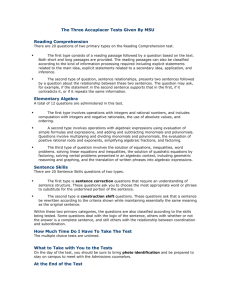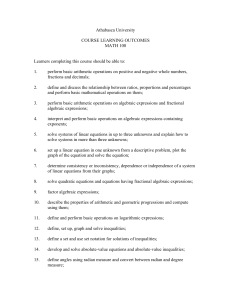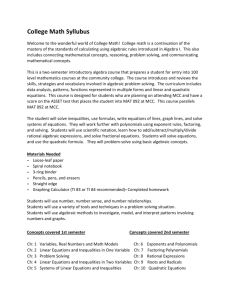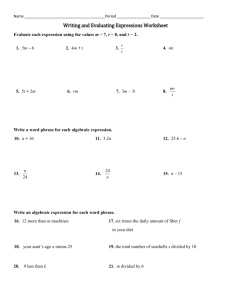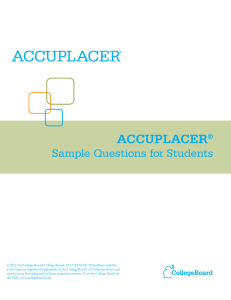A Closer Look at ACCUPLACER Tests
advertisement
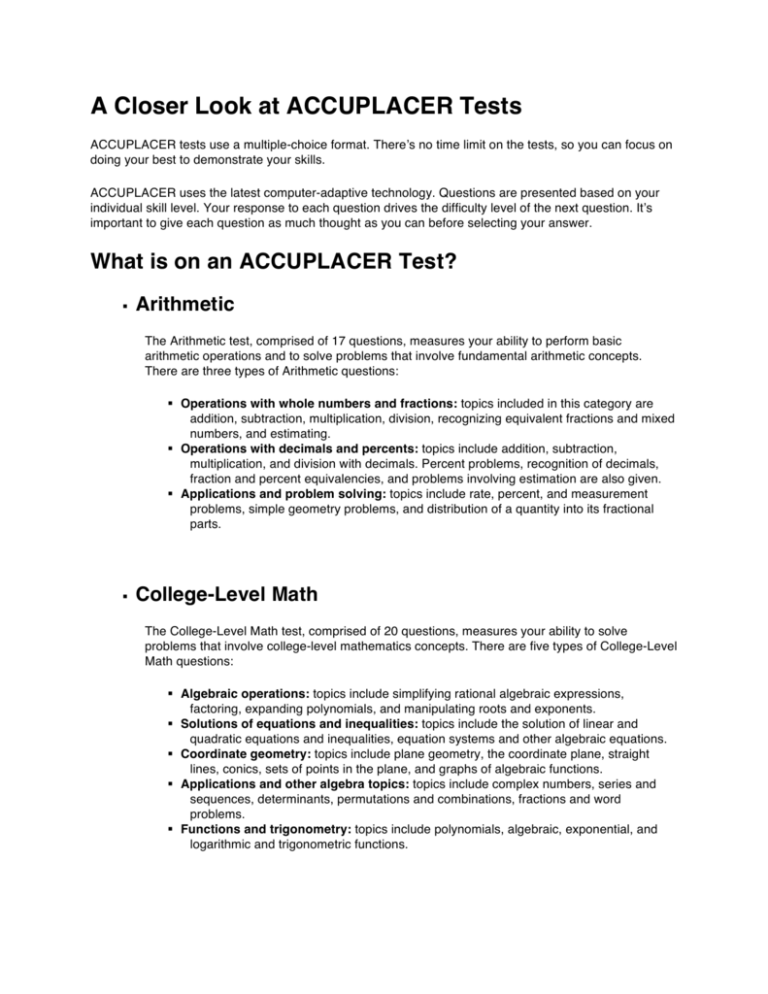
A Closer Look at ACCUPLACER Tests ACCUPLACER tests use a multiple-choice format. There’s no time limit on the tests, so you can focus on doing your best to demonstrate your skills. ACCUPLACER uses the latest computer-adaptive technology. Questions are presented based on your individual skill level. Your response to each question drives the difficulty level of the next question. It’s important to give each question as much thought as you can before selecting your answer. What is on an ACCUPLACER Test? § Arithmetic The Arithmetic test, comprised of 17 questions, measures your ability to perform basic arithmetic operations and to solve problems that involve fundamental arithmetic concepts. There are three types of Arithmetic questions: § Operations with whole numbers and fractions: topics included in this category are addition, subtraction, multiplication, division, recognizing equivalent fractions and mixed numbers, and estimating. § Operations with decimals and percents: topics include addition, subtraction, multiplication, and division with decimals. Percent problems, recognition of decimals, fraction and percent equivalencies, and problems involving estimation are also given. § Applications and problem solving: topics include rate, percent, and measurement problems, simple geometry problems, and distribution of a quantity into its fractional parts. § College-Level Math The College-Level Math test, comprised of 20 questions, measures your ability to solve problems that involve college-level mathematics concepts. There are five types of College-Level Math questions: § Algebraic operations: topics include simplifying rational algebraic expressions, factoring, expanding polynomials, and manipulating roots and exponents. § Solutions of equations and inequalities: topics include the solution of linear and quadratic equations and inequalities, equation systems and other algebraic equations. § Coordinate geometry: topics include plane geometry, the coordinate plane, straight lines, conics, sets of points in the plane, and graphs of algebraic functions. § Applications and other algebra topics: topics include complex numbers, series and sequences, determinants, permutations and combinations, fractions and word problems. § Functions and trigonometry: topics include polynomials, algebraic, exponential, and logarithmic and trigonometric functions. § Elementary Algebra The Elementary Algebra test, comprised of 12 questions, measures your ability to perform basic algebraic operations and to solve problems involving elementary algebraic concepts. There are three types of Elementary Algebra questions: § Operations with integers and rational numbers: topics include computation with integers and negative rationals, the use of absolute values, and ordering. § Operations with algebraic expressions: topics include the evaluation of simple formulas and expressions, adding and subtracting monomials and polynomials, multiplying and dividing monomials and polynomials, the evaluation of positive rational roots and exponents, simplifying algebraic fractions, and factoring. § Solution of equations, inequalities, word problems: topics include solving linear equations and inequalities, solving quadratic equations by factoring, solving verbal problems presented in an algebraic context, including geometric reasoning and graphing, and the translation of written phrases into algebraic expressions. § Reading Comprehension The Reading Comprehension test, comprised of 20 questions, measures your ability to understand what you read, to identify main ideas and to make inferences. You need to distinguish between direct statements and secondary or supporting ideas. § Sentence Skills The Sentence Skills test, comprised of 20 questions, measures your understanding of sentence structure — what makes a sentence complete and clear. Some questions deal with the logic of the sentence, and others with the relationships between two sentences.
